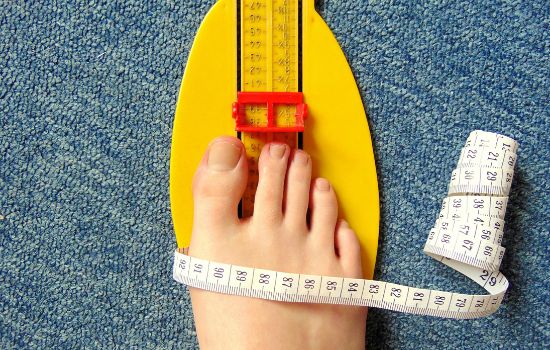Shopping for kids’ shoes can be an arduous task. There’s nothing worse than spending the money on a shoe only to later realise it isn’t quite right or having your child complain they are uncomfortable. One thing that can be very difficult with a kid’s growing feet is finding the perfect sized shoe. Let’s make that step a bit easier with some tips for finding your child’s shoe size.

Pick the right time to measure or shop
Everyone’s feet have a tendency to swell slightly during the day. After you have spent more time on your feet and particularly in warmer weather, the tissues in your feet and ankles can swell. This is particularly relevant in Queensland summer!
It is recommended that any measuring of the feet or trying on of footwear happens towards the end of the day, not first thing in the morning or after a lot of inactivity. After-school or sport is an ideal time for this.

Find your child’s shoe size by getting professionally measured for length AND width
If you stick to shopping in dedicated footwear retailers, most will measure the width and length of your child’s feet. Ensure both feet are measured! It is perfectly common and normal for one foot to be wider or longer than the other.
If you are shopping online, there are a number of printable measuring guides you can use too.
Check the fit of the shoes on their feet
Get your kid to stand up in the shoes. Then check:
- There should be one thumbs width from the longest toe (not always the big toe) to the end of the toebox.
- You should be able to just fit one finger around the insides of the heel cup.
- Hold the heel of the shoe on the ground and ask your child to try and lift their heel – there should be minimal movement. If there is, you either need to tighten the shoes, or try a narrower fit
- Run your fingers across the top of the shoe in a pinching motion – you should be able to create a small amount of movement/bunching in the material. Too much means they are too loose/wide, and too little means the shoes are too narrow/shallow for your child’s foot.

Let your child test the shoes
If the fit of the shoes seems reasonable based on the previous step, then let your kid take them for a test drive. Get them to walk, jog, jump, skip – try and replicate ‘real life’ as much as possible.
If it’s your child’s shoe size:
Then the shoes should be immediately comfortable! Kids shoes should not need breaking in.
If your child is complaining of foot pain or leg pain but you aren’t sure if you need to seek help, check out this article on when your child might need to see a podiatrist.


